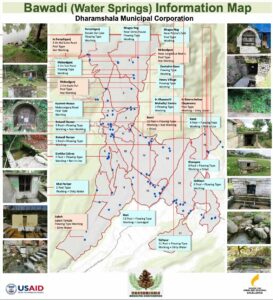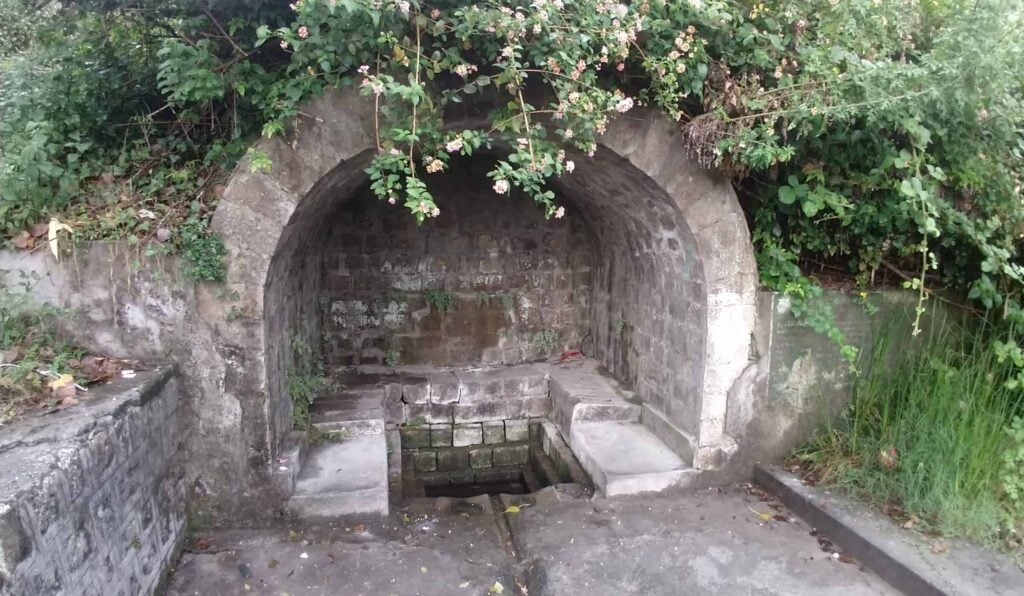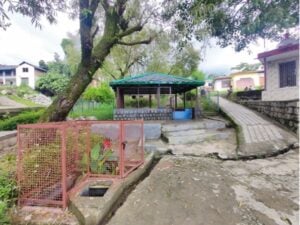Centre for Urban and Regional Excellence
As the city of Dharamshala in Kangra, Himachal Pradesh works toward becoming a ‘Smart City’, it is experiencing a population surge. In response, the city administration has focused on developing roads and certain public utilities. Amidst this, the city is experiencing water stress and must prioritise water management over its ongoing development plans.
People in Dharamshala largely depend on perennial streams, whose supply is not enough to meet the growing water demand. The perennial streams Bather Khad and Chauran Khad, and springs and tubewells, collectively supply 5.9 million litres of water to the city each day, far below the estimated demand of 7.2 million litres per day. As a result, the average household here only receives an hour’s piped water supply each day, and women of the community are forced to spend substantial time and energy fetching water from afar.
Meanwhile, the mountain springs (or baoris) that recharge the rivers are drying up, for several reasons. The springs are under continuous stress due to negligence, demographic pressure, and unplanned growth. As village areas are converted to municipal areas in the rural-urban transition underway, the urban administration grows in size and traditional practices that are more effective at restoring baoris tend to be forgotten. As non-glacial rivers are usually recharged by spring waters, the drying up of springs will also dry out the rivers, threatening the communities and ecosystems interdependent with them.
The region’s mountain springs are drying up for the following reasons:
- Land-use patterns are being changed[1] to include deforestation, (unplanned) construction, mining, road building, and the construction of dams.
- Local communities are neglecting the maintenance of these springs.
- Insufficient hydrogeological understanding, and limited exploration and scientific knowledge of the flow patterns of mountain springs.
- Global warming is leading to increasingly unpredictable rainfall patterns that limit the volume of groundwater recharge as intense rainfall results in floods and surface runoffs that rapidly move the water downstream.
- Lack of institutional capacity, with few institutes in the country working on spring shed management and few educational institutes that offer courses in the area, created a dearth of skilled people to work on spring rejuvenation.
- Lack of policy support caused by the lack of hydrogeological understanding has resulted in the neglect and exclusion of initiatives in water resource planning.
Responsibility for water supply, sewage systems, and pollution control is divided among different entities in Dharamshala. While the water resource department, the Jal Shakti Vibhag, works on water supply and the provision of sewage systems at a central level, the Urban Local Body provides utility services within settlements, and the Pollution Control Board is responsible for controlling pollution in the major streams.
These agencies need technical guidance to revive the spring shed to support the water supply in urban regions. CURE India has initiated spring revival work by identifying water-related challenges and mapping baoris in the area to support water management in Dharamsala. Using an ecosystem approach in implementation, CURE connects the dots to create an enabling environment for water resilience.
- Mapping and Documenting all Baoris in the Dharamshala Municipal Corporation: CURE has identified over 125 baoris and geotagged their locations. The information has been added to a standard inventory of information that is linked to a central repository. This enables the upscaling of a spring inventory, thus lowering the significant cost of data collection incurred by the local government and institute.

Dharamshala water spring location GIS map
- Audit of Baoris: CURE has developed a survey format to assess the basic characteristics of a baori, like location, altitude, type, ownership and management status, and historical use. It plans to estimate and capture the discharge rate of baoris with video details. It has calculated the discharge rate of 8 baoris in Dharamshala, estimated to provide 72.62 million litres of water annually assuming constant discharge. The initial findings are encouraging, and the local administration should scale up such initiatives to identify neglected baoris with significant flows.
- Water Quality Analysis and Participatory Planning: CURE plans to perform a water quality analysis to assess the usability of water from these springs. In the larger context, the team plans to perform participatory nano-planning for each baori, highlighting water and sanitation issues, mapping the catchment, preparing a plan for rejuvenation and developing some model sites for water harvesting – and initiating essential information gathering. Information, education and communication activities are also being performed to increase awareness amongst local communities and to use research findings to support the necessary policy reforms for reviving springs in Dharamshala. With the support of the local administration, such initiatives could be scaled up, and informed decisions could be made on water resource management in the city.
Water spring conservation: before (top) and after (bottom)
CURE’s full range of interventions has directly benefited over 100 households (about 500 people) with economic, ecological, health and social improvements. Audits reflect that baoris with significant flows will be redirected to households through pipelines. This water will be available for non-potable (washing) as well as potable uses (drinking). Tapping such natural sources sustainably will help alleviate the water stress being experienced by people in the city. The use of these springs has reduced the demand for and pressure on groundwater resources by an estimated 15%. Consequently, there is reduced energy consumption from groundwater pumping and booster pumps by households. This helps avoid carbon emissions, reduces street flooding, allows the groundwater to recharge, and greens the environment.
The city is expected to see potential savings of approximately INR 10,00,000 lakh (USD 1.2 trillion) in energy costs. This financial resource can be redirected to other development needs. On a smaller scale, access to quality drinking water has translated into reported savings of INR 100 (USD 1.20) a month per household in buying low-quality water, and INR 200 in medical expenses for gastrointestinal treatment. There is also potential for job creation – as these are old water springs built with traditional knowledge, training sessions can be conducted on how to construct and conserve these springs. Finally, the springs can be connected with agricultural farmland as an excellent source of irrigation, benefitting the livelihoods of farmers.
Given the increasingly evident impact of global warming and stressed water resources in the Himalayan range, CURE plans to extend the project towards the Himalayan range to build more water-resilient communities in future. Water springs are a great alternative water resource for any community and its government, yet despite the estimated 10,512 traditional water sources available in the villages of Himachal Pradesh, it was found that only 30.41% of the water sources are recharging properly.
This suggests significant potential to upscale the project, in terms of providing local governments with the expertise to identify, study, and revive them. Additionally, as the springs are strictly controlled and managed by the government, related work has been carried out by the government with a lack of community involvement or the contribution of local/indigenous knowledge.
With this in mind, we are developing a participatory approach with the local community and government to better incorporate local knowledge and needs. This includes local involvement in planning, design, demand assessment, resource mobilisation, labour, knowledge contribution, operation and management, especially by young people and women. In the longer run, we aim to facilitate the community takeover of these water resources, to ensure they are managed sustainably.
[1] Large-scale construction involves a great deal of blasting that impacts the delicate geology of the region. The impact on the subsurface arrangement of rocks, through which springs are both recharged and flow, is immense. As hydropower plants are diverting water from stream beds, depriving the soil of a means of water recharge, and debris from construction is often dumped into streams, water flow is inhibited.



















